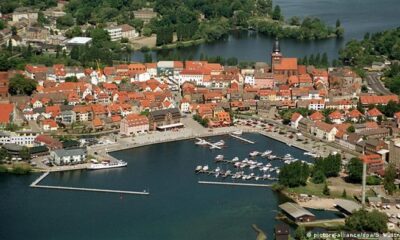
As the area surrounding Berlin, Brandenburg scores with lots of nature. Meadows, forests, and lakes. And then there are castles, mansions, gardens, and lots of space because the state is sparsely populated.

Potsdam
The capital of Brandenburg is also the most populous city in the state. The Prussian kings left many magnificent palaces and gardens to the former residence and garrison town. Potsdam has also made a name for itself as a center for film and science thanks to the traditional Babelsberg film studio and many universities and research institutes.

Sanssouci Palace
It is the most famous palace in Potsdam. The Prussian King Frederick II had it built in the Rococo style between 1745 and 1747. Sanssouci – without worry – the king wanted to be at his favorite summer residence and place of retreat. The palaces and gardens of the Sanssouci Park are part of the UNESCO World Heritage.

Beech forests
Brandenburg has even more UNESCO World Heritage sites to offer: the 670-hectare Grumsin, along with four other German beech forests, is part of the “Old Beech Forests” World Heritage Site. Grumsin is located in the Schorfheide-Chorin biosphere reserve north of Berlin.

Spreewald
In the Spreewald biosphere reserve, the Spree divides into hundreds of watercourses, so-called Fliese. Around 1000 river kilometers invite you to get to know the landscape by paddle boat or barge. The traditional boat still determines the everyday life of many Spreewald people. For a long time it was the only means of transport.

fieldstone churches
Fieldstone churches are churches built from boulders. The stones collected in the fields were mostly processed or unprocessed to build village churches. Like here in Herzberg in the Elbe-Elster district, there are still many fieldstone churches in the villages of Brandenburg. The majority dates from the 13th century.

Frankfurt (Oder)
There are two Frankfurts in Germany. One is in the west, the other – the smaller one – in the east, directly on the border river Oder. On the other bank is Frankfurt’s neighboring Polish city of Słubice, pictured above. Frankfurt (Oder) is also called Kleiststadt because the poet Heinrich von Kleist was born here in 1777.

Oder-Neisse cycle path
The Oder-Neisse cycle path also leads to Frankfurt (Oder). The cycle path is 630 kilometers long: It winds its way from the source of the Neisse in the Czech Republic along the German-Polish border to Ahlbeck on the Baltic Sea island of Usedom.

Niederfinow boat lift
The Niederfinow ship lift was established in 1934 and is the oldest still working ship lift in Germany. A height difference of 36 meters in the Oder-Havel canal is overcome with the huge “ship elevator”. More than 250,000 visitors visit the industrial monument every year.

Chorin Monastery
The former Cistercian monastery in Chorin is one of the most important monuments of early brick Gothic architecture in Brandenburg. Since 1964, the Chorin Music Summer has taken place here every year with classical concerts. Many visitors come with picnic baskets and blankets because the music can also be heard outside on the meadow in front of the monastery.

lakes
Out and about on the water with a canoe: If you’re lucky, you can be all alone on one of the more than 3,000 lakes in Brandenburg, even in summer. Like here on the Schwielowsee, one of the large lakes in the Havel River.

Must See
-




Tips
/ 1 year agoTen reasons for Amsterdam
Amsterdam mainly celebrates April 27th in Orange. The king’s birthday is traditionally celebrated with a...
-






Tips
/ 1 year agoTen travel tips for South Korea
A country between high-tech and tradition. A visit to East Asian South Korea is worthwhile...
-






Tips
/ 1 year agoTen reasons for Mecklenburg-West Pomerania
No other federal state has as much water as Mecklenburg-Western Pomerania. Baltic Sea waves wash...



